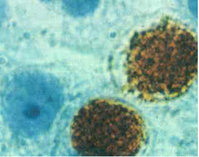The most commonly reported sexually transmitted disease in the United States is genital infection with Chlamydia trachomatis. This infection, when present during delivery, puts newborns at risk of developing conjunctivitis and pneumonia in the first few months of life. An estimated 100,000 newborns are exposed to C. trachomatis annually. Until recently, the recommendation was to treat these infants with a 14-day course of oral erythromycin. However, the use of this drug in newborns has been associated with an increased risk of pyloric stenosis. Because of this association, the current recommendation is watchful waiting and treating infants with erythromycin only after they develop symptoms related to C. trachomatis exposure. There currently are no studies determining the risks and benefits of this strategy. Rosenman and associates compared the use of erythromycin prophylaxis with watchful waiting in a hypothetic cohort of neonates exposed to C. trachomatis.
The study design was a decision tree analysis of 100,000 neonates (see accompanying figure). Potential outcomes included C. trachomatis conjunctivitis, C. trachomatis pneumonia (inpatient or outpatient), no clinical disease, and pyloric stenosis. The authors searched the literature to determine probability point estimations and ranges. They used estimated costs for each strategy as an outcome measure.
Using the decision tree analysis, prophylaxis with oral erythromycin in neonates after exposure to C. trachomatis would prevent 5,986 cases of C. trachomatis pneumonia, including 1,197 hospital admissions. However, the use of oral erythromycin would increase by 3,284 the number of neonates who developed pyloric stenosis. For every 30 infants treated with erythromycin, one additional case of pyloric stenosis would occur. The prophylaxis would prevent 1.8 cases of pneumonia per 30 neonates treated. A cost analysis established that watchful waiting would cost $15.1 million annually, while prophylaxis would cost $28.3 million. In another analysis of the data, if more than 3.4 percent of the neonates were hospitalized with pneumonia, prophylaxis with oral erythromycin would become more favorable. The authors conclude that their study supports the choice of watchful waiting for asymptomatic neonates who are exposed to C. trachomatis. They add that, in some circumstances, erythromycin prophylaxis may be appropriate because of the incidence of pneumonia requiring hospitalization.
Rosenman MB, et al. Oral erythromycin prophylaxis vs watchful waiting in caring for newborns exposed to Chlamydia trachomatis. Arch Pediatr Adolesc Med June 2003;157:565-71.
COPYRIGHT 2004 American Academy of Family Physicians
COPYRIGHT 2004 Gale Group



